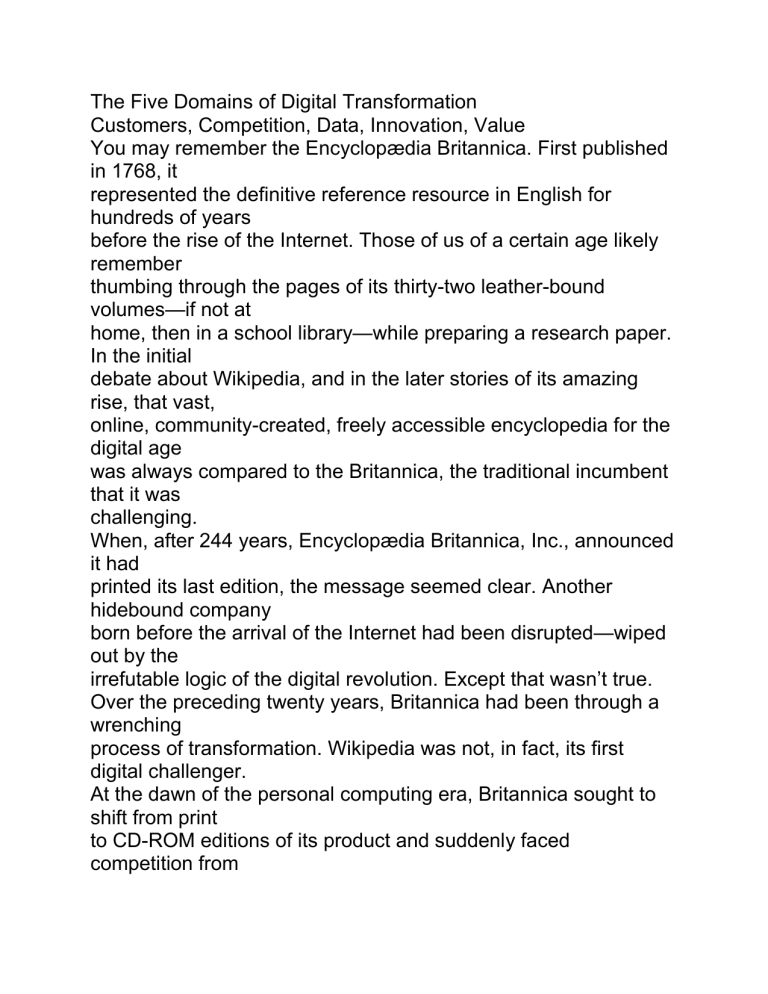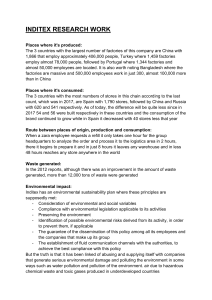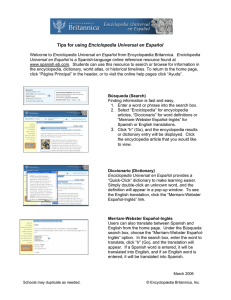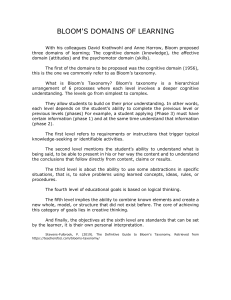
The Five Domains of Digital Transformation Customers, Competition, Data, Innovation, Value You may remember the Encyclopædia Britannica. First published in 1768, it represented the definitive reference resource in English for hundreds of years before the rise of the Internet. Those of us of a certain age likely remember thumbing through the pages of its thirty-two leather-bound volumes—if not at home, then in a school library—while preparing a research paper. In the initial debate about Wikipedia, and in the later stories of its amazing rise, that vast, online, community-created, freely accessible encyclopedia for the digital age was always compared to the Britannica, the traditional incumbent that it was challenging. When, after 244 years, Encyclopædia Britannica, Inc., announced it had printed its last edition, the message seemed clear. Another hidebound company born before the arrival of the Internet had been disrupted—wiped out by the irrefutable logic of the digital revolution. Except that wasn’t true. Over the preceding twenty years, Britannica had been through a wrenching process of transformation. Wikipedia was not, in fact, its first digital challenger. At the dawn of the personal computing era, Britannica sought to shift from print to CD-ROM editions of its product and suddenly faced competition from Microsoft, a company in a totally different industry: Microsoft’s Encarta encyclopedia was a loss leader, given away free on CD-ROM with purchases of Windows software as part of a larger strategy to position personal computers as the primary educational investment for middle-class families. As CD-ROMs gave way to the World Wide Web, Britannica faced competition from an explosion of online information sources, including Nupedia and later its exponentially growing, crowd-sourced successor, Wikipedia. Britannica understood that customers’ behaviors were changing dramatically with the adoption of new technologies. Rather than trying to defend its old business model, the company’s leaders sought to understand the needs of its core customers—home users and educational institutions, increasingly in the K–12 market. Britannica experimented with various delivery media, price points, and sales channels for its products. But, significantly, it maintained a focus on its core mission: editorial quality and educational service. With this focus, it was able not only to pivot to a purely online subscription model for its encyclopedia but also to develop new and related product offerings to meet the evolving needs for classroom curricula and learning. “By the time we stopped publishing the print set, the sales represented only about 1% of our business,” explained Britannica President Jorge Cauz on the anniversary of that decision. “We’re as profitable now as we’ve ever been.”1 The story of Britannica may seem surprising precisely because the setup is so familiar: powerful new digital technologies drive dramatic changes in customer behavior. Once started, the digitization of a product, interaction, or medium becomes irresistible. The old business model is invalidated. Inflexible and unable to adapt, the “dinosaur” business gets wiped out. The future belongs to the new digital pioneers and start-ups. But that’s not what happened with Britannica, and that’s not how it has to be for your business. There is absolutely no reason upstart digital companies have to supplant established firms. There is no reason new businesses have to be the only engines of innovation. Established companies, like Britannica, can set the pace. The problem is that—in many cases—management simply doesn’t have a playbook to follow to understand and then address the competitive challenges of digitization. This book is that playbook, intended to help you understand, strategize for, and compete on the digital playing field. Overcoming Your Digital Blind Spots An analogy may be helpful here. Back during the first wave of the Industrial Revolution, factories were dependent on fixed sources of power— first, water power from waterwheels located along rivers and, later, steam power from coalfired engines. Although these power sources enabled the rise of mass production, they set fundamental constraints as well. At the outset, they dictated where plants could be located and how productive they could be. Furthermore, because both waterwheels and steam engines demanded that all equipment in a factory be attached to a central drive shaft—a single long motor that powered every machine—these power sources dictated the design of factories and the way work could be done within them. With the spread of electrification to factories at the end of the nineteenth century, all of this changed. Electrical power eliminated all the constraints that had defined factories up until that point. Machinery could be arranged in the optimal order of work. Lines of production could feed into each other, like tributaries to a river, rather than all fitting in along one line shaft. Factory size was no longer limited by the maximum length of line shafts and belts. The possibilities for entirely new plant designs were breathtaking. And yet the incumbent plant owners were largely blind to these opportunities. They were so used to the assumptions and constraints of hundreds of years of plant design that they simply could not see the possibilities before them. It fell to the new electrical utilities, the “start-ups” of the electrification era, to evangelize for innovation in manufacturing. These new firms loaned electric motors for free to manufacturers just to get them to try the new technology. They sent trainers and engineers, also for free, to train the managers and workers at plants so that they could see how electric motors could transform their business. Progress was slow at first, but it turned out the utilities could teach some old dogs new tricks. By the 1920s, a new ecosystem of factories, workers, engineers, products, and businesses had taken shape, with electrical power at its center.2 Today, our digital-born businesses (such as Google or Amazon) are like the electrical companies of the early electrification era. And our savvy digital adopters (such as Britannica) are like the factories that learned to retool and advance into the next industrial age. Both types of businesses recognize the possibilities created by digital technologies. Both see that the constraints of the pre-digital era have vanished, making new business models, new revenue streams, and new sources of competitive advantage not only possible but also cheaper, faster, and more customer-centric than ever before. Let’s take a closer look at that world. Five Domains of Strategy That Digital Is Changing If electrification was transformative because it changed the fundamental constraints of manufacturing, then the impact of digital is even bigger because it changes the constraints under which practically every domain of business strategy operates. Digital technologies change how we connect and create value with our customers. We may have grown up in a world in which companies broadcast messages and shipped products to customers. But today the relationship is much more two-way: customers’ communications and reviews make them a bigger influencer than advertisements or celebrities, and customers’ dynamic participation has become a critical driver of business success. Digital technologies transform how we need to think about competition. More and more, we are competing not just with rival companies from within our industry but also with companies from outside our industry that are stealing customers away with their new digital offerings. We may find ourselves competing fiercely with a long-standing rival in one area while leveraging that company’s capabilities by cooperating in another sector of our business. Increasingly, our competitive assets may no longer reside in our own organization; rather, they may be in a network of partners that we bring together in looser business relationships. Digital technologies have changed our world perhaps most significantly in how we think about data. In traditional businesses, data was expensive to obtain, difficult to store, and utilized in organizational silos. Just managing this data required that massive IT systems be purchased and maintained (think of the enterprise resource planning systems required just to track inventory from a factory in Thailand to goods sold at a mall in Kansas City). Today, data is being generated at an unprecedented rate—not just by companies but by everyone. Moreover, cloud-based systems for storing data are increasingly cheap, readily available, and easy to use. The biggest challenge today is turning the enormous amount of data we have into valuable information. Digital technologies are also transforming the ways that businesses innovate. Traditionally, innovation was expensive, high stakes, and insular. Testing new ideas was difficult and costly, so businesses relied on their managers to guess what to build into a product before launching it in the market. Today, digital technologies enable continuous testing and experimentation, processes that were inconceivable in the past. Prototypes can be built for pennies and ideas tested quickly with user communities. Constant learning and the rapid iteration of products, before and after their launch date, are becoming the norm. Finally, digital technologies force us to think differently about how we understand and create value for the customer. What customers value can change very quickly, and our competitors are constantly uncovering new opportunities that our customers may value. All too often, when a business hits upon success in the marketplace, a dangerous complacency sets in. As Andy Grove warned years ago, in the digital age, “only the paranoid survive.” Constantly pushing the envelope to find our next source of customer value is now an imperative. Taken together, we can see how digital forces are reshaping five key domains of strategy: customers, competition, data, innovation, and value (see figure 1.1). These five domains describe the landscape of digital transformation for business today. (For a simple mnemonic, you can remember the five domains as CC-DIV, pronounced “see-see-div.”) Figure 1.1 Five Domains of Digital Transformation. Across these five domains, digital technologies are redefining many of the underlying principles of strategy and changing the rules by which companies must operate in order to succeed. Many old constraints have been lifted, and new possibilities are now available. Companies that were established before the Internet need to realize that many of their fundamental assumptions must now be updated. Table 1.1 sets out the changes in these strategic assumptions as businesses move from the analog to the digital age. Table 1.1 Changes in Strategic Assumptions from the Analog to the Digital Age Let’s dig a bit more deeply into how digital technologies are challenging the strategic assumptions in each of these domains. Customers The first domain of digital transformation is customers. In traditional theory, customers were seen as aggregate actors to be marketed to and persuaded to buy. The prevailing model of mass markets focused on achieving efficiencies of scale through mass production (make one product to serve as many customers as possible) and mass communication (use a consistent message and medium to reach and persuade as many customers as possible at the same time). In the digital age, we are moving to a world best described not by mass markets but by customer networks. In this paradigm, customers are dynamically connected and interacting in ways that are changing their relationships to business and to each other. Customers today are constantly connecting with and influencing each other and shaping business reputations and brands. Their use of digital tools is changing how they discover, evaluate, purchase, and use products and how they share, interact, and stay connected with brands. This is forcing businesses to rethink their traditional marketing funnel and reexamine their customers’ path to purchase, which may skip from using social networks, search engines, mobile screens, or laptops, to walking into a store, to asking for customer service in a live online chat. Rather than seeing customers only as targets for selling, businesses need to recognize that a dynamic, networked customer may just be the best focus group, brand champion, or innovation partner they will ever find. Competition The second domain of digital transformation is competition: how businesses compete and cooperate with other firms. Traditionally, competition and cooperation were seen as binary opposites: businesses competed with rival businesses that looked very much like themselves, and they cooperated with supply chain partners who distributed their goods or provided needed inputs for their production. Today, we are moving to a world of fluid industry boundaries, one where our biggest challengers may be asymmetric competitors— companies from outside our industry that look nothing like us but that offer competing value to our customers. Digital “disintermediation” is upending partnerships and supply chains—our longtime business partner may become our biggest competitor if that partner starts serving our customers directly. At the same time, we may need to cooperate with a direct rival due to interdependent business models or mutual challenges from outside our industry. Most importantly, digital technologies are supercharging the power of platform business models, which allow one business to create and capture enormous value by facilitating the interactions between other businesses or customers. The net result of these changes is a major shift in the locus of competition. Rather than a zero-sum battle between similar rivals, competition is increasingly a jockeying for influence between firms with very different business models, each seeking to gain more leverage in serving the ultimate consumer. Data The next domain of digital transformation is data: how businesses produce, manage, and utilize information. Traditionally, data was produced through a variety of planned measurements (from customer surveys to inventories) that were conducted within a business’s own processes— manufacturing, operations, sales, marketing. The resulting data was used mainly for evaluating, forecasting, and decision making. By contrast, today we are faced with a data deluge. Most data available to businesses is not generated through any systematic planning like a market survey; instead, it is being generated in unprecedented quantities from every conversation, interaction, or process inside or outside these businesses. With social media, mobile devices, and sensors on every object in a company’s supply chain, every business now has access to a river of unstructured data that is generated without planning and that can increasingly be utilized with new analytical tools. These “big data” tools allow firms to make new kinds of predictions, uncover unexpected patterns in business activity, and unlock new sources of value. Rather than being confined to the province of specific business intelligence units, data is becoming the lifeblood of every department and a strategic asset to be developed and deployed over time. Data is a vital part of how every business operates, differentiates itself in the market, and generates new value. Innovation The fourth domain of digital transformation is innovation: the process by which new ideas are developed, tested, and brought to the market by businesses. Traditionally, innovation was managed with a singular focus on the finished product. Because market testing was difficult and costly, most decisions on new innovations were based on the analysis and intuition of managers. The cost of failure was high, so avoiding failure was paramount. Today’s start-ups have shown us that digital technologies can enable a very different approach to innovation, one based on continuous learning through rapid experimentation. As digital technologies make it easier and faster than ever to test ideas, we can gain market feedback from the very beginning of our innovation process, all the way through to launch, and even afterward. This new approach to innovation is focused on careful experiments and on minimum viable prototypes that maximize learning while minimizing cost. Assumptions are repeatedly tested, and design decisions are made based on validation by real customers. In this approach, products are developed iteratively through a process that saves time, reduces the cost of failures, and improves organizational learning. Value The final domain of digital transformation is the value a business delivers to its customers—its value proposition. Traditionally, a firm’s value proposition was seen as fairly constant. Products may be updated, marketing campaigns refreshed, or operations improved, but the basic value a business offered to its customers was assumed to be constant and defined by its industry (e.g., car companies offer transportation, safety, comfort, and status, in varying degrees). A successful business was one that had a clear value proposition, found a point of market differentiation (e.g., price or branding), and focused on executing and delivering the best version of the same value proposition to its customers year after year. In the digital age, relying on an unchanging value proposition is inviting challenge and eventual disruption by new competitors. Although industries will vary as to the exact timing and nature of their transformation by new technologies, those who assume it will be a little farther down the road are most likely to be run over. The only sure response to a shifting business environment is to take a path of constant evolution, looking to every technology as a way to extend and improve our value proposition to our customers. Rather than waiting to adapt when change becomes a matter of life or death, businesses need to focus on seizing emerging opportunities, divesting from declining sources of advantage, and adapting early to stay ahead of the curve of change. A Playbook for Digital Transformation Faced with transformation in each of these five domains, businesses today clearly need new frameworks for formulating their own strategies to successfully adapt and grow in the digital age. Each of the domains has a core strategic theme that can provide you with a point of departure for your digital strategy. Like the engineers who trained the traditional factory managers, these five themes can guide you, revealing how the constraints of your traditional strategy are changing and how opportunities are opening up to build your business in new ways. I call this set of strategic themes the digital transformation playbook. Figure 1.2 depicts this playbook on one page, along with many of the key concepts we will explore in this book as we examine each theme in detail. In doing so, it illustrates how the building blocks of your playbook for digital transformation fit together. Let’s look at each of the five themes to understand them a bit better. Figure 1.2 The Digital Transformation Playbook. Harness Customer Networks As customers behave less like isolated individuals and more like tightly connected networks, every business must learn to harness the power and potential of those customer networks. That means learning to engage, empower, and co-create with customers beyond the point of initial purchase. It means leveraging the ways that happy customers influence others and drive new business opportunities. Harnessing customer networks may involve collaborating with customers directly, like the fans of Doritos snack chips who create its awardwinning advertisements or the drivers using Waze who provide the input that powers its unique mapping system. It may involve learning to think like a media company, like cosmetics giant L’Oréal or industrial glassmaker Corning, both of whose content has been spread far and wide by networked customers. Other organizations, like Life Church and Walmart, are connecting with customers by finding the right moment in their digital lives for the value each organization is offering. Long-established companies, from Coca-Cola to Maersk Line, are sparking social media conversations with internal and external customers in industries as diverse as soft drinks and container shipping services. Today, creating an effective customer strategy requires that you understand such key concepts as customers as strategic assets, the reinvented marketing funnel, the digital path to purchase, and the five core behaviors of customer networks (accessing, engaging, customizing, connecting, and collaborating).








